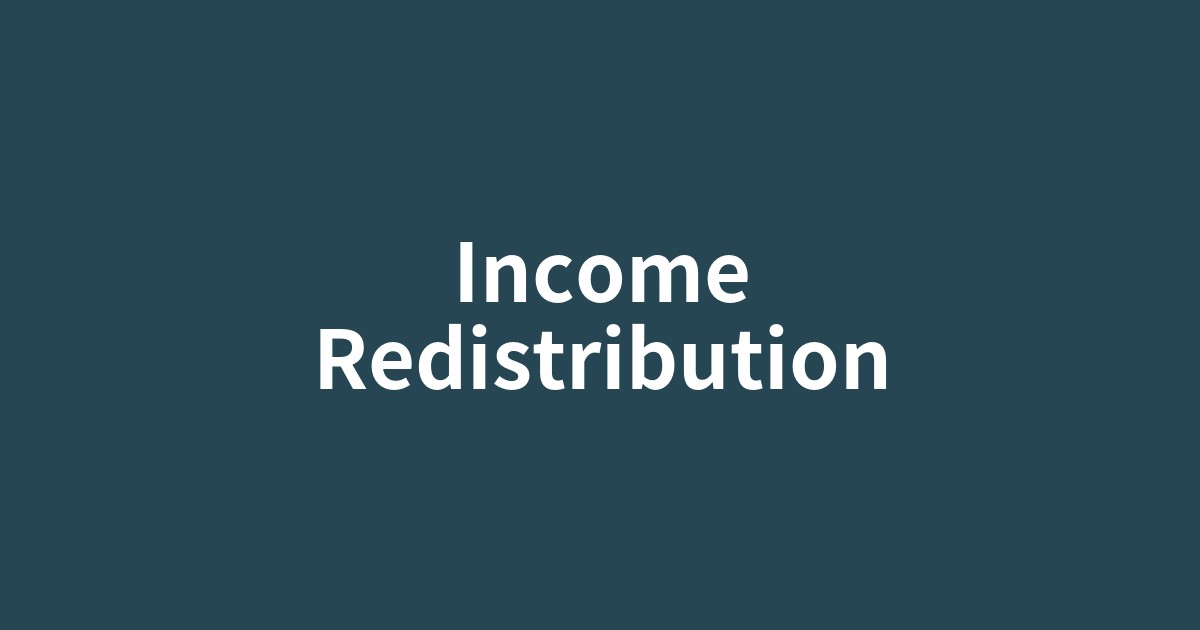このページは、歴史や文化の物語を楽しみながら、その文脈の中で重要な英単語を自然に学ぶための学習コンテンツです。各セクションの下にあるボタンで、いつでも日本語と英語を切り替えることができます。背景知識を日本語で学んだ後、英語の本文を読むことで、より深い理解と語彙力の向上を目指します。

【ご注意】
この記事には、健康、金融、法律など、読者の人生に大きな影響を与える可能性のある情報が含まれています。内容は一般的な情報提供を目的としており、専門的なアドバイスに代わるものではありません。重要な判断を下す前には、必ず資格を持つ専門家にご相談ください。
累進課税や社会保障制度を通じて、豊かな人から貧しい人へ所得を移転させること。格差を是正し、社会の安定を図るfunction(機能)。
この記事で抑えるべきポイント
- ✓所得の再分配とは、市場経済によって生じる所得格差を、税金や社会保障を通じて是正し、社会の安定を図る仕組みであること。
- ✓再分配の主な手段は、高所得者ほど高い税率を課す「累進課税」と、病気や失業、老齢などのリスクに備える「社会保障制度」の2つであること。
- ✓近代的な再分配の思想は、産業革命後の貧富の差の拡大を背景に生まれ、世界恐慌や福祉国家の理念を経て、国家の重要な機能として定着していった歴史があること。
- ✓再分配の適切な度合いをめぐっては、経済的な効率性や個人の勤労意欲との関係から、「大きな政府」と「小さな政府」の立場で様々な議論が存在すること。
所得の再分配 ― 税金と社会保障の役割
「なぜ私たちは税金を払うのだろう?」多くの人が一度は抱くこの疑問。給与明細から引かれる税金や社会保険料を見て、負担に感じることも少なくないでしょう。しかし、この仕組みは単なる負担ではなく、実は社会全体のバランスを保つための重要な「所得の再分配」という機能を持っています。この記事では、私たちの生活と密接に関わるこの仕組みについて、その本質と歴史を紐解いていきます。
The Redistribution of Income: The Role of Taxes and Social Security
"Why do we pay taxes?" It's a question many of us have asked at some point. Looking at the taxes and social security contributions deducted from our paychecks, it's easy to feel the burden. However, this system is not merely a burden; it actually has an important function of maintaining the balance of society as a whole, known as "income redistribution." In this article, we will explore the essence and history of this mechanism that is so closely intertwined with our lives.
なぜ「再分配」は必要なのか?―市場経済の光と影
私たちが生きる現代社会の多くは、自由な競争を原則とする市場経済、すなわち資本主義(capitalism)のシステムで成り立っています。このシステムは、技術革新を促し、経済を成長させる大きな力を持っています。しかしその一方で、競争の結果として勝者と敗者が生まれ、富を持つ者と持たざる者の間に所得格差(inequality)が生じることは避けられません。この格差が過度に拡大すると、社会的な対立や不安を引き起こし、社会全体の安定を揺るがしかねません。そこで必要となるのが、この格差を是正するための「所得の再分配(redistribution)」という考え方です。これは、市場の原理だけでは解決できない問題を、人為的な仕組みで調整しようとする社会の知恵なのです。
Why is "Redistribution" Necessary? The Light and Shadow of the Market Economy
Most of the modern societies we live in are based on a market economy system, or capitalism, which operates on the principle of free competition. This system has the great power to foster technological innovation and drive economic growth. On the other hand, it is inevitable that competition produces winners and losers, leading to income inequality between the haves and have-nots. If this gap widens excessively, it can cause social conflict and unrest, threatening the stability of society as a whole. This is where the idea of "redistribution" of income becomes necessary to correct this disparity. It is the wisdom of society to try to adjust, through an artificial mechanism, problems that cannot be solved by market principles alone.
再分配の二大エンジン ― 税金(Tax)と社会保障(Social Security)
所得再分配を実現するための具体的な手段は、大きく分けて二つあります。一つ目のエンジンが「税金(tax)」です。特に、所得が高い人ほど高い税率が課される「累進課税(progressive taxation)」は、再分配の根幹をなす仕組みです。高所得者からより多くの税金を集め、それを公共サービスや社会保障の財源とすることで、富が社会全体に行き渡るよう促します。二つ目のエンジンは「社会保障」です。年金、医療保険、雇用保険といった制度は、病気や失業、老齢といった人生で誰もが遭遇しうるリスクに備えるためのセーフティネット(safety net)としての役割を果たします。これにより、困難な状況に陥った人々も最低限の生活を維持でき、再び社会で活躍する機会を得ることができるのです。
The Two Great Engines of Redistribution: Tax and Social Security
There are two main instruments for achieving income redistribution. The first engine is the tax system. In particular, progressive taxation, where people with higher incomes are subject to higher tax rates, is the cornerstone of redistribution. By collecting more taxes from high-income earners and using them to fund public services and social security, it promotes the distribution of wealth throughout society. The second engine is social security. Systems such as pensions, medical insurance, and employment insurance serve as a safety net to prepare for risks that anyone may encounter in life, such as illness, unemployment, or old age. This allows people who have fallen on hard times to maintain a minimum standard of living and gives them the opportunity to be active in society again.
歴史から見る「再分配」思想の変遷 ― 福祉国家の誕生
所得再分配という考え方が、国家の重要な役割として定着するまでには長い歴史がありました。その源流は、産業革命によって貧富の差が深刻化した19世紀のヨーロッパに遡ります。1880年代、ドイツの宰相ビスマルクは、世界に先駆けて疾病保険や年金保険といった社会保険制度を導入しました。これは、労働者の不満を和らげ、国家の安定を図る狙いがありました。その後、1929年の世界恐慌は、市場の自己調整能力には限界があることを世界に示し、ケインズ経済学のように政府(government)が積極的に経済に介入すべきだという考え方が主流となります。この流れの中で、国民の生活を最低限保障する「福祉国家(welfare state)」という理念が広まり、所得再分配は国家の重要な機能として確立されていきました。
The Evolution of Redistributionist Thought Through History: The Birth of the Welfare State
The idea of income redistribution had a long history before it became established as an important role of the state. Its origins can be traced back to 19th-century Europe, where the gap between rich and poor became severe due to the Industrial Revolution. In the 1880s, German Chancellor Bismarck introduced a social insurance system, including sickness and pension insurance, ahead of the rest of the world. This was intended to appease the discontent of the workers and stabilize the state. Later, the Great Depression of 1929 showed the world that there were limits to the self-regulating capacity of the market, and the idea that the government should actively intervene in the economy, as advocated by Keynesian economics, became mainstream. In this context, the concept of the "welfare state," which guarantees a minimum standard of living for its citizens, spread, and income redistribution was established as an important function of the state.
現代における再分配の課題 ― 終わらない「大きな政府」か「小さな政府」かの議論
しかし、所得再分配は万能の解決策ではありません。その適切な度合いをめぐっては、今なお活発な議論が続いています。一方には、高い税負担や手厚い社会保障が、人々の働く意欲や企業の投資意欲を削ぎ、経済全体の活力を失わせてしまうという批判があります。これは、政府の役割を最小限に留め、市場の自由に任せるべきだという「小さな政府」の立場です。他方で、格差の放置は社会不安を増大させ、結果的に経済成長を阻害するため、政府が積極的に介入して再分配を強化すべきだという「大きな政府」の立場も根強く存在します。どの程度の再分配が社会にとって最適なのか。この問いに唯一絶対の正解はなく、各国の歴史や価値観を反映しながら、政治的な議論が続けられているのです。
Contemporary Challenges in Redistribution: The Unending Debate of "Big Government" vs. "Small Government"
However, income redistribution is not a panacea. There is still a lively debate about its appropriate degree. On one hand, there is criticism that high tax burdens and generous social security can dampen people's willingness to work and corporate investment appetite, leading to a loss of overall economic vitality. This is the "small government" position, which argues that the role of government should be kept to a minimum and left to the freedom of the market. On the other hand, there is also a strong "big government" position, which argues that neglecting inequality increases social unrest and ultimately hinders economic growth, and therefore the government should actively intervene to strengthen redistribution. What level of redistribution is optimal for society? There is no single right answer to this question, and the political debate continues, reflecting the history and values of each country.
結論
所得の再分配は、単に富を一方から他方へ移すだけの仕組みではありません。それは、資本主義というシステムの構造的な欠点を補い、社会全体の連帯を育み、安定を維持するための重要な社会的機能(function)なのです。私たちが毎月支払う税金や社会保険料が、どのように社会を支え、巡り巡って自分たちの生活の安定にも繋がっているのか。その意味を理解することは、私たちがどのような社会を目指すべきかを考えるための、確かな第一歩となるでしょう。
Conclusion
Income redistribution is not just a mechanism for transferring wealth from one party to another. It is an important social function that compensates for the structural flaws of the capitalist system, fosters social solidarity, and maintains stability. Understanding how the taxes and social security contributions we pay each month support society and, in turn, contribute to the stability of our own lives is a solid first step in considering what kind of society we should aim for.
テーマを理解する重要単語
function
この記事の結論で、所得再分配の本質を定義するために使われる重要な単語です。「重要な社会的機能」と表現することで、再分配が単なる政策や制度を超え、社会全体が健全に維持されるために不可欠な「働き」を持っていることを強調しています。この単語は、再分配の存在意義をマクロな視点から理解するのに役立ちます。
文脈での用例:
Each part of the system has a specific function.
システムの各部分には特定の機能がある。
inequality
所得再分配がなぜ必要とされるのか、その根源的な理由を示す単語です。この記事では、市場経済が必然的に生み出す「所得格差」を指しています。この単語を理解することで、再分配が単なる経済政策ではなく、社会の安定を脅かすほどの「不平等」という問題への対策なのだという文脈が明確になります。
文脈での用例:
The report highlights the growing inequality between the rich and the poor.
その報告書は富裕層と貧困層の間の拡大する不平等を浮き彫りにしている。
compensate
結論部分で、所得再分配の核心的な機能を説明するために使われている動詞です。「資本主義というシステムの構造的な欠点を補う」とあるように、再分配が単なる富の移動ではなく、システム全体の弱点を「補う」ための重要な調整機能であることを示しています。この単語により、再分配の持つ建設的な側面が強調されます。
文脈での用例:
Nothing can compensate for the loss of a loved one.
愛する人を失った埋め合わせは、何ものにもできない。
intervene
政府が市場に積極的に関与する行為を指す動詞で、再分配の議論において極めて重要です。世界恐慌後、政府が経済に「介入」すべきだという考えが主流になったと記事は説明しています。「大きな政府」の立場を理解する上で、この「介入」という概念が何を意味するのかを掴むことが不可欠です。
文脈での用例:
The government had to intervene in the financial crisis.
政府は金融危機に介入しなければならなかった。
mechanism
所得再分配という抽象的な概念を、具体的な「仕組み」として捉えるために使われる単語です。記事では「人為的な仕組みで調整する」「再分配の根幹をなす仕組み」など、繰り返し登場します。この単語に着目することで、税金や社会保障が、社会の課題を解決するために設計された意図的な「メカニズム」なのだという視点が得られます。
文脈での用例:
Scientists are studying the mechanism by which the virus attacks the immune system.
科学者たちは、そのウイルスが免疫系を攻撃する仕組みを研究している。
capitalism
この記事が論じる社会経済システムの土台となる概念です。自由競争による経済成長という「光」の側面と、格差を生む「影」の側面を併せ持つものとして描かれています。所得再分配が、この「資本主義」というシステムの構造的な欠点を補うために考案された社会の知恵であることを理解する上で不可欠な単語です。
文脈での用例:
Capitalism is an economic system based on private ownership.
資本主義は私有財産制に基づく経済システムです。
solidarity
この記事が示す所得再分配の究極的な目的の一つを表現する単語です。結論部分で「社会全体の連帯を育む」と述べられている通り、再分配は経済的な格差是正だけでなく、社会の構成員が互いに支え合うという意識、すなわち「連帯」を醸成する機能も持つことを示唆しています。再分配の社会的な意義を深く理解する鍵となります。
文脈での用例:
Workers showed solidarity with their striking colleagues.
労働者たちは、ストライキ中の同僚たちとの連帯を示した。
redistribution
記事全体の主題である「所得の再分配」を指す最重要単語です。富や資源を一度集め、異なる基準で配り直すという概念を理解することが、この記事の核心を掴む鍵となります。税金や社会保障が、単なる徴収ではなく、社会のバランスを保つための意図的な「再分配」の仕組みであることを示しています。
文脈での用例:
The government's policy focuses on the redistribution of wealth through taxation.
政府の政策は、税制を通じた富の再分配に焦点を当てている。
social security
税金と並ぶ、所得再分配のもう一つの重要なエンジンです。年金、医療、雇用保険など、人々が人生で直面する様々なリスクに備える制度全体を指します。この記事では、人々が困難な状況に陥っても最低限の生活を維持できるようにする「セーフティネット」としての役割を担っていると解説されています。
文脈での用例:
The government is reforming the social security system to cope with the aging population.
政府は高齢化社会に対応するため、社会保障制度を改革しています。
safety net
社会保障制度の役割を比喩的に表現する重要な言葉です。元々はサーカスの「安全網」を指しますが、経済的な困難から人々を守る最後の砦という意味で使われます。この記事では、社会保障が失業や病気といった不測の事態から人々を救い、再起の機会を与えるための不可欠な仕組みであることを象徴しています。
文脈での用例:
Unemployment benefits provide a safety net for those who have lost their jobs.
失業手当は、職を失った人々にとってのセーフティネットとなる。
panacea
「万能薬」を意味し、この記事では所得再分配が抱える課題や限界を示す文脈で使われています。「再分配は万能の解決策ではない」という一文で、理想論だけではなく、その適切な度合いをめぐる現実的な議論の存在を読者に伝えます。この少し格式高い単語は、議論の複雑さと奥深さを表現するのに役立っています。
文脈での用例:
Technology is not a panacea for all our problems.
テクノロジーは我々のすべての問題に対する万能薬ではない。
progressive taxation
所得再分配を実現するための具体的な手段の一つとして挙げられている専門用語です。所得が高いほど税率も高くなるこの仕組みが、再分配の根幹であると説明されています。この言葉を知ることで、税金がどのようにして富を社会全体に行き渡らせる機能を持つのか、その具体的なメカニズムを理解することができます。
文脈での用例:
Progressive taxation is designed to reduce the tax burden on people with lower incomes.
累進課税は、低所得者の税負担を軽減するように設計されている。
welfare state
所得再分配という思想が国家の機能として確立された形態を指す言葉です。記事では、世界恐慌を経て、政府が国民の最低限の生活を保障すべきだという理念が広まった結果として「福祉国家」が誕生したと述べられています。再分配の歴史的な変遷と、その理念がどのような国家像に結びついたかを理解する上で鍵となります。
文脈での用例:
Sweden is often cited as a model of a successful welfare state.
スウェーデンは、成功した福祉国家のモデルとしてしばしば引用される。